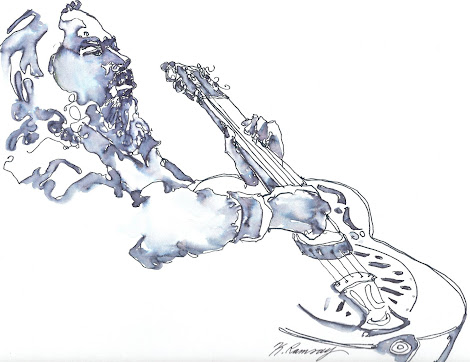Razor sharp arrangements that find balance between the booty and the brain
4.0/5.0 




The sad truth is that studio tricks have leveled the playing field between barely capable musical clods and their more talented competition. A good engineer can make almost any band sound tight, with every pitch perfect note placed precisely on beat. That kind of work, though, leaves its fingerprints on the music. But listening to the interwoven horn parts and the hand-in-glove coordination between the bass and drums on
Atomga’s full-length release,
Black Belt, it’s clear that the recording engineers didn’t have sweeten these tracks; they just needed to capture the tightest of takes and focus on the mix. Their top-notch production brought the clarity to showcase everyone’s talent. Atomga has such a strong team ear for the groove that, even as they push themselves technically, the album never turns into a parade of egos. Instead, the album is packed with quiet epiphanies where you notice just how spot-on a particular part is.
Black Belt starts out appropriately enough with a brief musical kata that lets Atomga show off their Afrobeat form. Compared to any of Fela Kuti’s tracks, the instrumental “Salt and Pepper” is quite abbreviated, but it demonstrates the tight horn arrangements that the band is known for. The song starts out with a call and response between the horns and Casey Hrdlicka’s guitar exclamation points, but the verse changes gears and pits Alice Hansen’s trumpet against Frank Roddy’s and Leah Concialdi’s saxes. Then the tune takes it even higher with Concialdi locking into a hypnotic baritone sax riff that Hansen surfs cleanly over.
That introduction sets up a strong start to the album, where each track raises the bar. The second song, “Sly Devil”, is quite a bit moodier than the opener, with reggae and Latin influences creeping in. A simple guitar loop begins the tune, but it’s really all about the drums and percussion; they’re locked into the beat, but they never settle for simple repetition. The bass fits right in: relatively busy, but steady on. The horns contrast with the rhythmic complexity by holding longer tones -- the raspy caress of baritone sax is just about perfect. Kendra Kreie’s vocal is soulful and warm, even as her knowing tone makes it clear that she’s not buying the sly devil’s line. Peter Mouser’s organ solo is another treat as it slips into a beautifully retro Ray Manzarek style jam, reminiscent of the middle section of “Riders on the Storm”.
If “Sly Devil” is laid back with a bit of weary cynicism, my favorite track, “
Cressidation”, is altogether heavier with powerful soul-gospel roots. Right from the start it’s more insistent, taking an anxious edge from the crisp, funky guitar chords, but the horns soften some of that tension. Concialdi swaggers through her solo with braggadocio, as if reassuring the nervous guitar. At first, Kreie's relaxed vocal seems a bit disengaged, but by the chorus, she picks up a righteous tone that closes the energy gap. Hrdlicka's jazzy solo is exquisitely phrased and I love how he plays just outside the lines. That sets up a dreamy interlude, where Samual Lafalce takes a richly melodic turn on bass before dropping some speedy funk runs. Hrlicka responds with a more aggressive second shot that ushers in the soulful chorus to take it home.
The rest of
Black Belt carries on following the basic Afrobeat aesthetic that balances between the booty and brain. The feel-good music is danceable and blurs the lines between funk and jazz, but it’s also the medium for the songs’ socially conscious messages. Tracks like “Alaskan Pipeline” take advantage of that to provide cultural commentary, but the grooves defuse any risk of a hectoring tone.
If
Black Belt has a flaw at all, it's that the clean production and razor sharp arrangements are almost too perfect. Not because of studio sleight of hand -- the songs are quite lively -- but more because the flow of smooth takes encourages the listener to take it all for granted. Without the risk of failure, the album misses some of the magical chaos that the band often finds onstage. Still, it’s a rare studio that can capture that kind of lightning. All in all, it's a fair trade.











 One of the things I love about Matt Steven's music is that he doesn't just alternate between visceral guitar expression and intellectually satisfying geometric balance. Instead, he blends them together into a spicy melange that milks excitement and intensity from that dichotomy. Even in a short 1:41 piece like "
One of the things I love about Matt Steven's music is that he doesn't just alternate between visceral guitar expression and intellectually satisfying geometric balance. Instead, he blends them together into a spicy melange that milks excitement and intensity from that dichotomy. Even in a short 1:41 piece like " The sad truth is that studio tricks have leveled the playing field between barely capable musical clods and their more talented competition. A good engineer can make almost any band sound tight, with every pitch perfect note placed precisely on beat. That kind of work, though, leaves its fingerprints on the music. But listening to the interwoven horn parts and the hand-in-glove coordination between the bass and drums on
The sad truth is that studio tricks have leveled the playing field between barely capable musical clods and their more talented competition. A good engineer can make almost any band sound tight, with every pitch perfect note placed precisely on beat. That kind of work, though, leaves its fingerprints on the music. But listening to the interwoven horn parts and the hand-in-glove coordination between the bass and drums on